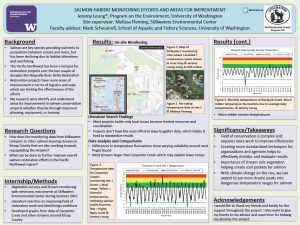Salmon Habitat Monitoring Efforts and Areas for Improvement
Salmon has been an ecologically and economically important subject in the Pacific Northwest region for time immemorial. From providing nutrients to a wide range of animals like orcas and bears to creating jobs in the multi-million dollar fishing industry, salmon continues to be a key species that many communities rely on for support. The problem arises when overfishing and human-made obstructions have limited salmon populations from recovering through the blockage of important habitat for growth. Within the recent two decades, multiple restoration and monitoring efforts have been implemented to restore salmon. The purpose of this study was to participate in one of these monitoring efforts to see the complexities of restoration work at Carpenter Creek led by Stillwaters Environmental Center in Kingston. To accomplish this task, I interned with Stillwaters to gather and analyze stream water data following the procedures with several volunteers, and corroborated the data with several literature articles on ideal salmon habitat and ways to optimize restoration. The resulting data was compiled into an infographic used by Stillwaters for the public. The findings from the work showed that there have been several times throughout the years of monitoring data in which certain spots of Carpenter Creek were nonoptimal for salmon development. Due to the way that data was taken only once a month by volunteers, methods of monitoring could be improved at a larger scale, as noted by several literature articles to improve the field of restoration work.
